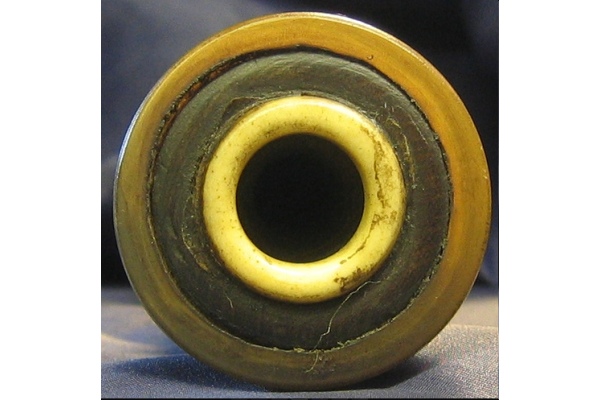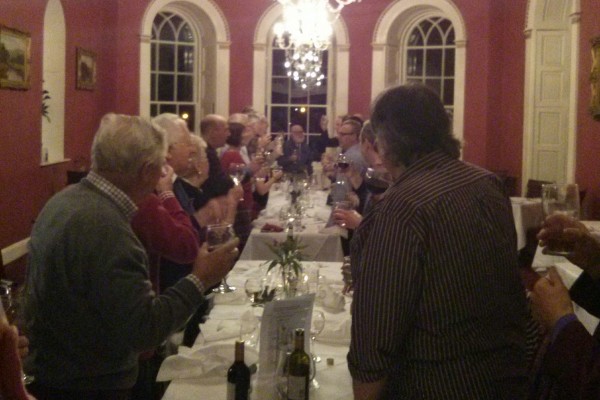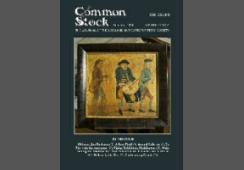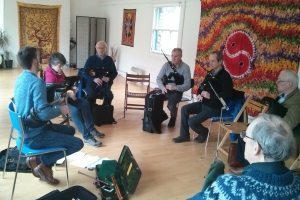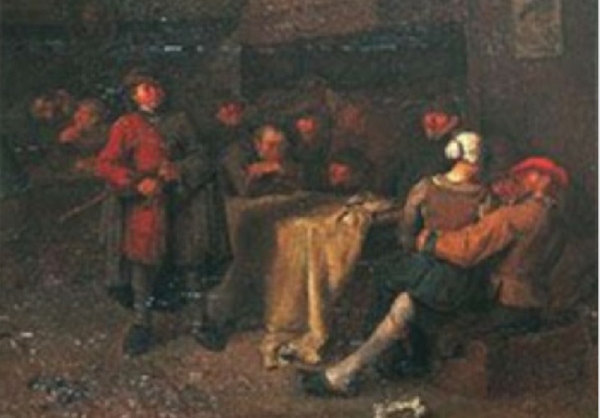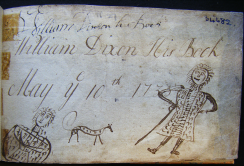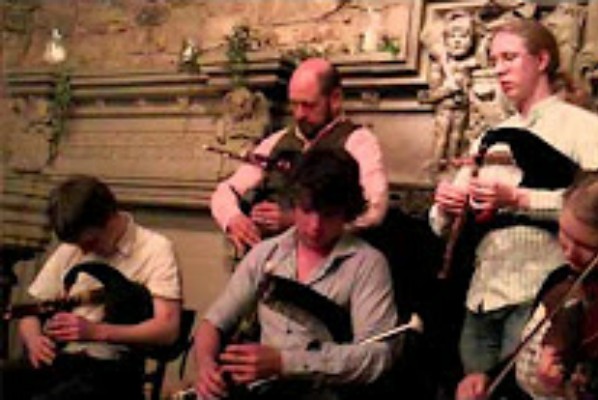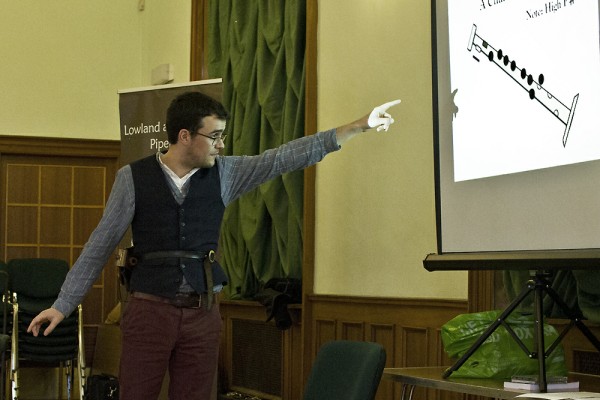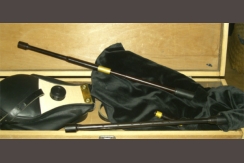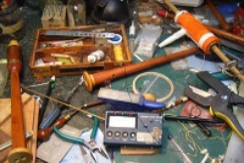





John Dally
Gordon Mooney once joked, “When asked why the bagpipe had drones, the old piper re- plied, ‘Well, without the drones you might as well play the piano’”. i There’s more truth to that than appears at first glance, because unlike the piano the bagpipe is a harmonic instru- ment. The drones form the basis for the harmonics produced by the interplay between them- selves and the chanter, making it an instrument unsuited for playing a tempered scale. An- other way of putting it is, the piano is made for music of modulated chords whereas the bag- pipe is made for modal, harmonic music.
Drones are basic to the bagpipe sound, so much so that we may take them for granted. A chanter by itself is pleasant enough, but a beautiful set of drones makes a sound that is a thing of wonder. The longer you listen to well-balanced, well-tuned drones the more you hear. First you hear the fundamental notes of the drones braided together, then the harmon- ics or overtones, then the fabric of sound woven by all these elements together, which is a sum greater than its parts.
Most of us grew up listening to music of modulating chords, so we have to learn to hear the subtleties in harmonically based music. Music that features a drone is harmonically based, whether it is Indian, Tibetan, Tuvan, Gaelic or Anglo-Saxon. Harmonics are so basic to ex- perience that your ear recognizes them before you do. I think this is one thing about bag- pipes that makes them appealing to people from all sorts of different cultures.
There are many examples of music that use a drone sound but do not involve bagpipes. Per- haps the most basic form of drone music is vocal. When anyone sings you hear harmonics in their voice, but many musical traditions are built on harmonics. “Based on a traditional style of throat singing called hoomi, from the Tuvic region of Mongolia many contemporary
chanters have learned to produce two distinct pitch lines: the
fundamental note which is sustained as a drone; while simul- taneously singing a piercing, whistling melody line of over- tones.”ii Perhaps throat singing, which predates bagpipes, in- spired the first bagpiper to discover his instrument.
Harmonic music is not merely a step in the progressive devel- opment that resulted in the tempered scale and modulating
Perhaps throat singing,
which predates bagpipes, inspired the first bagpiper to discover his instrument
chords. Some purists think that the tempered scale is unnatural and a distortion. “We might add that to sing without accompaniment the tempered scale is an undertaking beyond hu- man capacities, because we cannot, without strong external help, escape from harmonic in- tervals, which alone are in accordance with the physical nature of sounds and consequently with the shapes and possibilities of the organs by which we can emit and perceive them.”iii
Harmonics are basic and profound. “When you first be- come aware of harmonics as a phenomenon of sound, your entire way of listening becomes altered.” iv They are mysterious and have been studied by scientists and philoso- phers for nearly as long as we can remember. Pythagoras believed harmonics to be the ultimate expression of the
Pythagoras believed harmonics to be the ultimate expression of the music of the spheres
music of the spheres. Many traditions, modern and ancient, believe harmonics are a source of healing and spiritual power? The German poet Novalis (1772 to 1801) said, “Every ill- ness is a musical problem and every cure a musical solution.”vi
There is a difference between harmonics and harmony. Many pipers seem to be confused by this. In part two of The College of Piping Tutor for the Highland Bagpipe it is clearly stated, “The job of the drones is to provide a background of harmony for the melody played on the pipe chanter.”vii A more accurate job description for the drones would be to say they pro- vide a background of consonance and dissonance for the melody played on the pipe chanter, the scale of which is designed to meld with and enhance the harmonics produced by the drones.
Anthony Baines does not use the word ‘harmony’ to describe the function of drones in either his Bagpipes or Woodwind Instruments and Their History. “There can be no question- ing that for a full and satisfying Accompaniment to a simple air, the drone is hard to beat.
Even today, old traditional airs that we have grown accustomed to stuff with conventional harmonies on piano or accordion, often gain fresh life when played over a simple drone.”viii
He goes on to write, “A single drone (the commonest arrangement in the Middle Ages) is nearly always tuned two octaves below the chanter key-note.”ix The significance of this is explained by examining the weave of harmonics between the well-tuned chanter and drones. “All bagpipers, even the wildest shepherds in the southern mountains of Europe, tune their drones with the greatest care and with complete absence of hurry, for everything in bagpiping depends upon the drone being exactly in tune with the chanter.”x It is essential in the best tuning that the drones underpin every note of the chanter’s scale. xi
The word ‘harmonics’ derives from the Indo-European root ‘ar’, which also gave us ‘army’, ‘order’, ‘hatred’, ‘aristocracy’, ‘arithmetic’, and ‘rhyme’. Its oldest form meant, ‘to fit to- gether’. And it came to us through both the Greeks via the Romans as well as the Anglo Saxons, from whom we get another derivative, ‘riddle’. xii The art of tuning is in the ability to use your ear to line up the frequencies of drones and chanter so that they fit together like a perfect rhyme resonating through time.
We pipers say a well-tuned pipe will ‘lock on’, describing how the frequencies line up and seem to pull each other into a fifth element. This satisfying fit of various sounds is mapped out in the golden section, a set of proportions that some claim to be the basic pattern of the universe. The pyramids, fractals, Stone Henge, Paisley shawls, natural forms such as shells, leaves and human bodies, have the same proportion as the harmonic series. xiii When the frequencies line up, when the pipe is said to lock on, the harmonics line up like the colours of the spectrum in a laser beam. Before they were properly tuned the frequencies were like a prismatic assortment of colors.
If we plot out the harmonic progression of drones on a circular graph you will see the pro- portion is exactly that of a nautilus shell, an atmospheric weather pattern, and the logarith- mic spirals of intersecting points of the eyes of a peacock’s tail.
By plotting the harmonic intersection of frequencies emanating from different drones we can see why some configurations fit together better than others. In the table below you will find the four types of drones used in configuring a Border or Lowland pipe. The octaves of bass, tenor and fundamental note of the chanter line up. The baritone drone does not corre- spond with a harmonic from the other two drones until its third harmonic level, and does not meet the chanter’s fundamental until its seventh level and the chanter’s second. We hear this and find it less than completely satisfying.
The fundamental tone of the alto drone, however, links with the bass, and its second har- monic level links with the bass and tenor together. The alto’s harmonics correspond with the harmonics of the chanter’s fundamental note at the same place as the baritone, much sooner in its harmonic series. These figures show you what your ear tells you when you hear the difference between a Border or Lowland pipe configured with a baritone drone versus one configured with an alto drone.
The progression of fundamental frequencies from bass to tenor to alto to chanter corre- sponds directly with the bass’s harmonic progression. The baritone is out of sync.
The number of harmonics produced by the bass is why it is so important to the bagpipe’s sound, and probably why most bagpipes in the Middle Ages, as Baines pointed out, featured a bass drone.
The typical Scottish or Northumbrian small pipe, with bass, baritone and tenor, uses a smaller range of pitches than the Border or Lowland pipe. The fundamental note of the small pipe chanter is the same as the tenor drone, and only an octave above the bass. The baritone is an octave below the perfect fifth of the pipe chanter, which is in tune with the second harmonic of the bass drone.
Now that we have established that the drones provide a harmonic background, it is easy to understand why different modes, or pentatonic scales, still
produce a pleasant sound with the drones even when the key of the tune is not that of the drones. For example, ‘Paddy’s Leather Breeches’ in B minor still resonates well with the drones, even though the drones are tuned to A, a step below the fundamental note of the tune.
In fact, the sound of the drones will seem to change when the
well-tuned, warm
drones reflect the tonal colours of the tune being played on
the chanter.
key of the tune being played changes. You can hear this if you play ‘Paddy’s Leather Breeches’ in A followed immediately by the same tune in B minor. This is one reason why so many pipe tunes are made using a double tonic structure, and why so many tunes sound blasé without drones. xiv Well-tuned, warm drones reflect the tonal colours of the tune be- ing played on the chanter.
The design of the bore of the chanter determines which harmonics are stronger than others, giving the chanter its particular character or timbre. Pipers usually refer to this quality as tone. Generally speaking, a conically bored chanter has a loud, bright, brassy tone, while a cylindrically bored chanter has a quiet, mellow, smooth sound. The cylindrically bored chanters of the Northumbrian small pipe and its sibling, the modern Scottish smallpipe, lend themselves to a variety of drone tunings.
Northumbrian small pipe makers began making drones that could be tuned to a variety of musical keys, called complicated drones, when they put keys on the chanter to extend the range. The addition of keys to the chanter took place around 1800. Robert Reid of Northum- berland made a seven key set for Henry Clough in around 1810. xv
Several years ago I had the idea for a Scottish smallpipe that would allow'a similarly wide variety of drone tunings in combination with chanters pitched in different keys. My experi- ence playing Scottish smallpipes for ten years, and Northumbrian small pipes for twenty, pointed me in this direction.
With the help of Jim McGillivray I found Ray Sloan, pipe maker in Wark, Northumberland. Ray understood what I wanted and agreed to make the instrument with an ingenious sliding pin system on the drones.
Ray’s efforts resulted in a Scottish smallpipe with five permanent drones and three inter- changeable chanters.
The chanters are in A, C and D The drones play three notes each, shown below:
The range of drone tunings on the A chanter are shown here (the ‘5th indicates where the baritone drone is tuned). The keys indicate modes rather than true keys and are based on pentatonic scales:
On the C chanter:
Only three different, basic drone tunings are completely satisfying for each chanter playing traditional tunes. At least, this is my experience. They are, using the A chanter as our basis, A, B minor and D. The first time I played a tune in D with D drones on an A chanter was an amazing experience. D.A. Fraser, writing in 1907, disliked tunes in D because he felt they clashed with the drones in A. He suspected tunes in D were the result of composers working on the practice chanter rather than the pipes themselves. xvi There are too many older tunes in D, however, to support his suspicion, even if many of these tunes came from the fiddle and song repertoires.
Here is a contemporary tune made by Chris Ormston. It goes very well on the Scottish smallpipe with drones in D.
When playing tunes that begin in A but resolve in D, I have found, with tenor and bass in A, tuning the baritone drone to the fourth (D) rather than the fifth (E) to be attractive. Tunes in D that take to this tuning as well as a straight D drone tuning are ‘The Glen Where the Deer Is’ xviii ‘Lindisfarne’ by Matt Seattle, xix and ‘Joan’s Jig’ by Henry Clough. xx
The simplest octave drone tuning of tenor and bass is the best when playing a raft of tunes that progress through a series of key changes. Playing medleys of tunes that progress through key changes is a modem and not a traditional practice among Scottish folk musi- cians. xxi If you play a raft of tunes in the same key then using complicated drones tuned to that key will enhance your performance.
Pipe tunes often use a double tonic, starting with a phrase in A major, for example, then re- peating it in G or B minor, then returning to repeat the phrase in A major before concluding with a resolving phrase. Drones tuned to the fundamental note of the first phrase heighten the tension between the phrases, increasing the contrast that is finally resolved in the con- cluding phrase. Examples of tunes that feature the double tonic are ‘The Edinburgh Volunteers’, xxii ‘The Braw Lads of Jedhart’, xxiii and Peacock’s ‘Highland Laddie’. xxiv
You can tune the tenor and bass to the fundamental note of the first mode, and add another drone or two tuned to the pitch shared by the two contrasting modes. In ‘Caber Feidh’, xxv for example, you find phrases in G and A. Tuning the bass and tenor to A and the baritone to D, which is the fourth of the A phrase and the fifth of the D phrase, works well. With five drones to work with, other elements can be added to achieve more layers of tone color. But as painters know, too many colors mixed together make mud.
Usually, less is more.
The potential for traditional and non-traditional drone based music is greatly expanded with
an instrument like the one Ray made for me. The combina- tions of tones and potential harmonic affects are numerous with five drones. Ray’s reeds are very stable at each pitch of the drone. They do not take tremendous amounts of air, and are not too loud even with all five drones going at the same time. The smooth tone characteristic of Ray’s pipes is crucial to the balance.
The combinations of tones and potential harmonic affects are numerous with five
drones.
Here are a few different tunings for the A chanter that I have experimented with:
Experimenting and playing with specialized tunings is a solo affair. The bagpipe in its essence is a solo instrument. When playing with guitars, pianos or other back up, chording instruments, the accompanying instruments bury the subtleties of even the simplest drone under layers of modulating chords. I use two drones set up on the octave of the fundamental note or no drones at all when playing with accompanying instruments.
The drones alone are very effective when accompanying a singer. The harmonic qualities of the human voice act upon the background of the drones in much the same way as the pipe chanter. The result can be spine tingling. I suppose this comes as no surprise. We call the melody pipe a chanter, after all.
Jock Agnew has a favourite tuning technique you may wish to try, and it does not require a battery of drones. It works especially well on the Border pipe with two tenors and a bass. After you have tuned all three drones with painstaking perfection to the chanter, then take one of the tenors slightly out of tune, listening to the beats that come from the clash of slightly out of tune frequencies. This can produce a gentle undulation in the sound of the drones very similar to that characteristic of a tamboura in classical Indian music [as the pan- pipers do in the Andes to thicken the sound! Ed]. This works on the Highland pipe as well, but don’t try it in competition.
In the last few decades forward thinking pipers invested a lot of energy in pairing traditional bagpipes with electronic instruments and modem idioms in the pursuit of a contemporary, commercial sound. As exciting as this movement is, drones suffered neglect in the process. The bagpipe will only be heard to its full potential in the wider world if the drone element is developed. A chanter treated with synthesized chords in an attempt to make the bagpipe pal- atable to a wide audience becomes a primitive oboe.
Composers working at the cutting edge of ambient and environmental music today under- stand drones and the intricacies of tuning. These cutting edge artists have as much interest in game theory, bioacoustics, mantras, myth and physics as they do melody and rhythm.
Brian Eno’s ‘Neroli’ xxvi and Phill Niblock’s xxvii ‘Early Winter’ are two accessible examples.
Jon Hassell, another avant garde composer, told David Toop in an interview, “If you have a constant background like a drone, you can project your own nervous system against the background. You become aware of listening high, listening low, listening foreground, listen- ing background. That was the beginning from which Terry Riley, Steve Reich, Philip Glass, and the whole minimalist thing came from.” xxviii Terry Riley, who studied classical Indian music, said, “In the coming years, the frontier will be tuning.” xxix
Bagpipes have always thrived on the frontier. I hope the coming years will see the unique qualities inherent in our distinguished and pleasing instrument fully realized by pipers and non-pipers alike.
- Journal of the N American Association of Lowland and Border Pipers, #4, June 1992, 3.
- Gass, Robert, Chanting, Broadway Books, NY, NY, 1999, 59.
- Danielou, Alain, Music and the Power of Sound, Inner Traditions, Rochester, VT, p. 24.
- Goldman, Jonathan, healing Sounds, Element, Dorset, UK, 1996, 74.
- Gass, Robert, Chanting, Broadway Books, NY, NY, 1999, 58.
- Berendt, Joachim-Ernst, The World is Sound, Destiny Books, Rochester, VT, 1991, 121
- MacNeill, Seamus and Pearston, Thomas, The College of Piping Tutor for the Highland Bagpipe, part 2, Glasgow, 1968, 30.
- Baines, Anthony, Woodwind Instruments and Their History, Dover Publications, NY, 1991, p.
- Ibid 216
- Ibib 217
- Cannon, R.D., The Highland Bagpipe and its Music, John Donald Publishers, Edinburgh, 1995, p. 6.
- The American Heritage Dictionary of the English Language, Fourth Edition, Hough- ton Mifflin Co., Boston, 2000, 2021.
- Doczi, Gyorgy, The Powers of Limits, Shambala, Boston, 1981, pp 8 to
- Cannon, D., The Highland Bagpipe and its Music, John Donald Publishing, Edin-
- Ormston and Say, The Clough Family of Newsham, Northumbrian Pipers Society, Morpeth, Northumberland, 2000, 13 & 143.
- Cannon, D., The Highland Bagpipe and its Music, John Donald Publishers,
Edinburgh, 1995, p. 42
- http://www.blueskiesink.com/Ormston/compositions.htm
- Moore, Hamish, The Rumblin ’ Brig, Hamish Moore, Dunkeld, Scotland, 1993, p. 13.
- Seattle, Matt, The Border Bagpipe Book, Dragonfly Music, Newbiggen-by-the-Sea, UK, 1993, tune #30.
- Say et al, Border Bagpipe Tutor, Northumbrian Pipers Society, Morpeth, Northumberland, 2000, 18.
- Conversation with Barry Shears, Mike Saunders, Sue Truman, Stan Chapman, Seattle, April,
- p 39
- Say et al, Border Bagpipe Tutor, Northumbrian Pipers Society, Morpeth, Northumberland, 2000, 11.
- Agnew, Jock, A Collection of Pipe Tunes, The Northumbrian Pipers’ Society and The Lowland and Border Pipers’ Society, Morpeth and Edinburgh, UK, 1993, p. 21.
- Shears, Barry, The Gathering of the Clans Collection, Vol 11, Barry Shears, Halifax, NS, Canada, 2001, p. 43.
- Eno, Brian, Neroli, All Saints Records, Essex, UK,
- Niblock, Phill, Music by Phill Niblock, Experimental Intermedia Foundation, NY, NY,
- Toop, David, Ocean of Sound, Serpent’s Tail, London, UK, 1995, 178.
- p. 190
